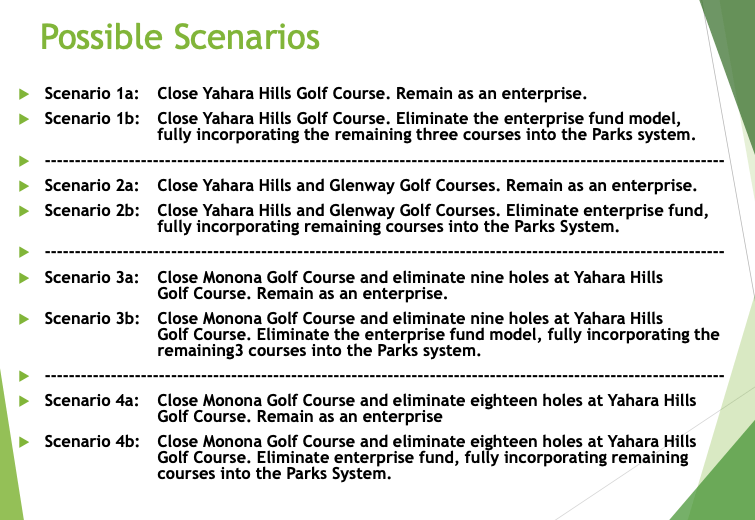Tomorrow the Task Force on Municipal Golf in Madison Parks will meet, and here are the options being provided to them.These options aren’t new, they are from February 19th. Since then, everything has changed, but there is no new information available on what the committee will discuss.
What I find interesting about this is the reduction in pesticides and fertilizer and what the potential uses of the land could be. It would be interesting to add that to the conversation. So people could balance golf vs. potential uses instead of golf, no golf and the Parks budget impacts.
SUMMARY OF POSSIBLE SCENARIOS
See the full powerpoint presentation here.
Scenario 1a – Close Yahara Hills Golf Course (36 hole reduction), Remain as Enterprise (Independent use)
Has the following impacts according to the powerpoint:
- 5.1 reduction in holes of golf in the Madison Metropolitan Area
- 33% of all rounds played (of 32,800)
- Will increase demand and cost to players at available courses
- 17 weekly leagues play there
- LaFollette, East, McFarland and Edgewood High School play there, including All-City Meet, 90% of City-hosted High School matches are held there
- Loss of 20 golf events/outings ($47,000)
- Lay off 49% of Golf Enterprise Program staff (2 of 7 FTE, 23,300 seasonal hours of work)
- 450 acres no longer managed as golf courses, would require reprogramming
- 45-50% reduction in fertilizer and pesticide, water (14.9M gallons) and electrical usage.
- 40-45% reduction in fuel usage
- It will impact the Golf Program Budget are outlined in the slides, but it could also result in elimination of the Unlimited Season Pass, reconfiguration of loyalty program, they may need more carts at other courses.
- It could impact the city budget by having a $74K decrease in PILOT payment as well as impact revenue from stormwater fees and inter-departmental overheat charges
- Only need $16.4-24.7 in capital budget – 44% reduction
- Rates at other courses my increase, and the growth potential at other courses is limited.
- If Yahara is closed, people don’t go to other city courses
- Loss of $185,210 per year to Golf Enterprise
Scenario 1b – Close Yahara Hills Golf Course, bring it in to the Parks System budget
- See above for all the impacts to golfers and community
- Changes dynamics of Operating and Capital budget process
- Net gain of $67,594 for Parks
Scenario 2a – Close Yahara Hills and Glenway Golf Courses (45 holes), remains as enterprise system
- 6.3 reduction in holes or 50% of all rounds played on city courses
- Will increase demand and cost to players
- 32 leagues would be impacted, LaFollette, East, West, Memorial, McFarland and Edgewood High Schools impacted
- 60% of college student rounds are played at Yahara and Glenway
- 27 golf events/outings, $54,000 in revenue
- 4 FTE laid off, 30,400 hours of seasonal labor
- 492 acres
- 55-60% reduction in fertilizer and pesticide and water usage 17.6M gallons)
- 50-55% reduction in electrical and fuel usage
- 70% reduction in golf memberships – could also result in elimination of the Unlimited Season Pass, reconfiguration of loyalty program, they may need more carts at other courses.
- It could impact the city budget by having a $125,496 decrease in PILOT payment as well as impact revenue from stormwater fees and inter-departmental overheat charges
- Only need $14.7-22.2 in capital budget – 60% reduction
- Rates at other courses my increase, and the growth potential at other courses is limited.
- Glenway was acquired as part of Forest Hill Cemetery
- When Yahara is closed, people don’t go to other city courses
- Anticipated loss of $190,275 per year.
Scenario 2b – Close Yahara Hills and Glenway Golf Courses, goes into parks system
- See above
- Parks budget gains $3,955 per year
Scenario 3a – Close Monona Golf Course and Eliminate 9 holes at Yahara Hills (18 hole reduction), stays as enterprise system
- 2.5% reduction in holds, 26% of rounds played
- Won’t increase prices at other courses
- 11 leagues impacted
- LaFollete could be accommodated within the system
- Loss of 7 golf outings ($4,500 in revenue)
- 1 FTE laid off, 5700 hours of seasonal labor
- 30-35% reduction in fertilizer and pesticide, water (6.9M gallons), electrical and fuel usage
- 15% reduction in golf membership, potential reconfiguration of Loyalty Program
- City budget will lose $125,496 in PILOT payment, storm water charges and inter-department overhead charges
- Only need $29.6-44.9 in capital budget – 20% reduction
- Opportunity for growth potential
- 30% of Monona player revenues would move to Yahara
- Loss of $233,183 per year
Scenario 3b – Close Monona, eliminate 9 holes at Yahara Hills, bring in to Parks Budget
- See above
- $176,312 gain to parks budget for the year.
Scenario 4a – Close Monona, Eliminate 18 holes at Yahara Hills, remains an enterprise (stand alone) budget
- 3.8% reduction in the 711 holds of golf in the Madison area, 18% of all rounds played
- Increase in cost to players in the local market
- 11 weekly leagues from Monona could be accommodated along with LaFollette high school
- 7 golf outings lost – $4,500 in revenue
- 1 Full time employee lost, 14,700 hours in seasonal labor
- 35-40% reduction in fertilizer and pesticide
- 30-35% reduction in water (7.4 million gallons)
- 15-20% reduction in electrical usage
- 30-35% reduction in fuel usage
- It could impact the city budget by having a $125,496 decrease in PILOT payment as well as impact revenue from stormwater fees and inter-departmental overheat charges
- Only need $19.4-36.9 in capital budget – 52-65% reduction
- 20% of Monona player revenue would move to Yahara
- Loss of $246,334 per year
Scenario 4a – Close Monona, Eliminate 18 holes at Yahara Hills, moves to Parks budget
- Net gain of $163,162 per year
HOW MUCH WILL THIS COST/SAVE THE CITY
As a bottom line presented by the city, we’re not talking a lot of money
But there could be a lot of potential . . . depending upon what the alternative plans are . . . again, I think that is where the interesting conversation lies.



Just to say no one has yet to talk about the value of the land appreciation. That appreciation of value on an annual basis might well exceed the claimed $168,000 in savings per year from closing the courses. Ten years from now that land will be even more valuable and may be worth millions more. Hasty decisions benefit no one.